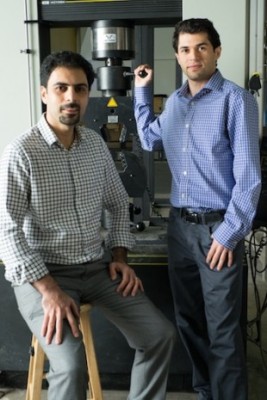Mar 18 2015
Researchers from Rice University have embarked on a study to design universal maps to forecast the characteristics of biomimetic and natural platelet-matrix composites.
 Rice researchers Rouzbeh Shahsavari, left, and Navid Sakhavand have created universal maps that predict the properties of natural and biomimetic platelet-matrix composites and synthetic stacks of materials like graphene and boron nitride. Photo by Jeff Fitlow
Rice researchers Rouzbeh Shahsavari, left, and Navid Sakhavand have created universal maps that predict the properties of natural and biomimetic platelet-matrix composites and synthetic stacks of materials like graphene and boron nitride. Photo by Jeff Fitlow
Researchers Rouzbeh Shahsavari and Navid Sakhavand from Rice University were inspired by the shimmering layer in mollusk shells such as mother-of-pearl to begin this study. They believe that their map will aid engineers and scientists better evaluate the critical stiffness, strength and toughness of composite materials used in numerous applications from buildings to nanoscale electronics.
According to the researchers, their maps created using the computer, do not have any dimensions, in the sense that they can be applied to nanoscale applications, to a brick structure as well as for something bigger.
“That’s the beauty of this approach: It can scale to something very large or very small,” said Shahsavari, an assistant professor of civil and environmental engineering and of materials science and engineering.
The map formula depends on four material features considered for developing a composite. These features include length, plasticity, ratio according to their individual stiffness, and the ability to overlap.
Those are the inputs, said Sakhavand, a graduate student in Shahsavari’s lab. “If you know them, you can predict the stiffness, strength and toughness of the final composite. We call this a universal map because all of those input parameters are relevant to all composites and their structural properties.”
Stiffness, strength and toughness are critical mechanical properties which hold significance to engineers and materials scientists. Stiffness can be defined as the manner in which a material withstands deformation, while strength is basically a material’s ability to remain together when compressed or stretched. A material’s ability to absorb energy prior to failure is termed as toughness.
The design maps created by the researchers indicated the rating of materials in all three categories and also show the positions at which they overlapped. The researchers’ aim was to not only aid engineers estimate the critical qualities of a material but also reduce the need for trial and error.
Shahsavari was initially inspired by the design and structure of nacre, which has high levels of strength and toughness. A closer look at the nacre via a microscope revealed a well-constructed brick wall with overlapping platelets of differing lengths combined together by thin elastic biopolymer layers.
“It has a very particular structure and property: It optimizes different mechanical properties at the same time.” Sakhavand said.
Nevertheless, so far it has been tough to engineer nacre-like composites, “mainly because of the lack of a design map that can reveal the various links between the structure, materials and properties of nacre-like materials,” Shahsavari said.
Shahsavari stated that their study is an essential milestone in paving the way for better ability to decode and duplicate the design and structure of the nacre for producing lightweight composites providing outstanding performance. He added that the new materials would be beneficial in the construction, aerospace, and auto industries.
The Rice researchers have been conducting several experiments to map the properties of natural composites such as spider silk and collagen on one hand and synthetic stacks such as silumin/alumina and hexagonal boron-nitride/graphene on the other hand for more than three years. Their theory was also tested at the macro-scale using 3D printed composites of hard plastic and soft rubber that imitated nacre’s properties.
The study culminated in the analysis of 15 materials. Natural ones such as nacre displayed properties which was tough and strong whereas synthetic materials were more stiff and strong.
Shahsavari expressed that he wishes for materials scientists to utilize their design maps to provide their composites with an excellent combination of all the three key properties.
The research findings were published in March 2015 Nature Communications.